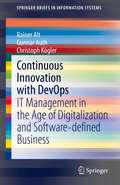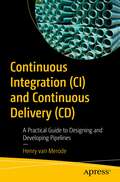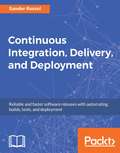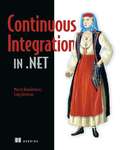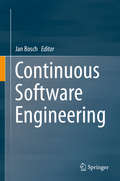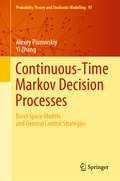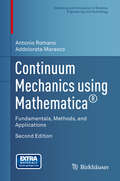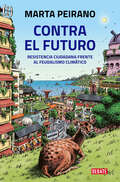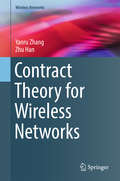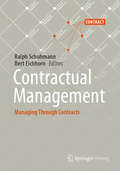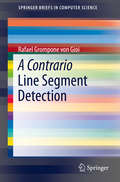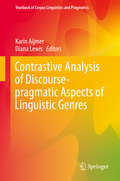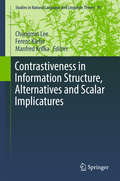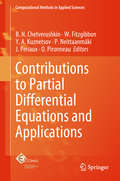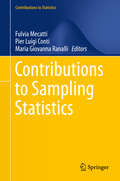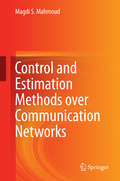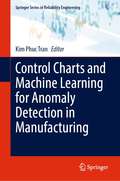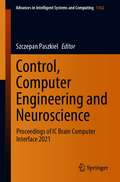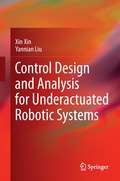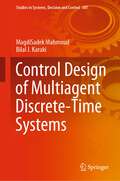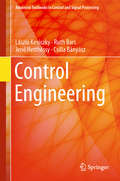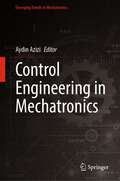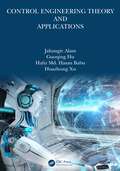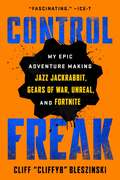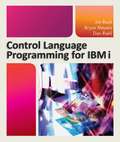- Table View
- List View
Continuous Innovation with DevOps: IT Management in the Age of Digitalization and Software-defined Business (SpringerBriefs in Information Systems)
by Rainer Alt Gunnar Auth Christoph KöglerThis book connects the new world of digitalization with classic IT management. With the presence of software in objects, products and processes, most businesses will become software-defined businesses. Software development and software management are thus key to stay competitive in an environment that demands continuous innovation. The authors provide a comprehensive introduction to continuous innovation, the DevOps concept and lay the foundations of an innovation-oriented IT management. The DevOps approach to continuous innovation, which combines lean and agile concepts with an automated tool chain, enables solutions that synergize fast (re)action through digital innovation on the one hand and long-term development cycles and stable operation on the other. A comprehensive case study of T-Systems MMS, a digital service provider from Deutsche Telekom in Germany, illustrates the use of this approach in practice.
Continuous Integration (CI) and Continuous Delivery (CD): A Practical Guide to Designing and Developing Pipelines
by Henry van MerodeUse continuous Integration (CI) and continuous delivery (CD) to improve the speed of software delivery. This book presents a game changer—how to use pipelines to automate the software delivery process. The theories about CI/CD are much the same, but the book covers what the development of pipelines looks like and how testing of pipelines themselves should be performed.Most teams just plunge into coding, without thinking about the CI/CD process itself. Why don’t we use the same development method for pipelines that we use for apps? Pipelines code development undergoes similar stages as application code development, such as requirements analysis, development, testing, implementation, operations, and monitoring. This is the starting point of the book. It describes the current challenges with pipeline development and how this process can be improved and structured. It describes in detail how to design pipelines and shows examples in BPMN 2.0 notation. What You’ll Learn Know the shortcomings and challenges of current pipeline development such as misalignment between the pipeline engineer and the team’s workflow, the use of infrastructure as code (IaC), and pipeline securityUnderstand the need for CI/CD requirements through the book's non-exhaustive list of more than 60 CI/CD requirements provided to inspire and increase awarenessSee how certain choices affect the way a pipeline is designed (and realized)Become familiar with branching strategy, build strategy, test strategy, release strategy, and deployment strategy that are explained in detail in the book, including their effect on pipeline designKnow how pipelines can be unit tested, using a real-world exampleKnow how performance bottlenecks in a pipeline occur, how they can be detected, and how they can be solvedView a complete implementation, including code, showing how the guidelines in this book are applied to a real use case Who This Book Is For DevOps engineers and solution architects involved with automating the software supply chain and using application lifecycle management (ALM)/integration platforms such as Jenkins, CircleCI, Bamboo, and Azure DevOps; intermediate and experienced DevOps engineers (developers, ops engineers, test engineers); and ICT managers interested in the CI/CD pipeline development domain
Continuous Integration, Delivery, and Deployment
by Sander RosselGetting started with the processes and the tools to continuously deliver high-quality software About This Book • Incorporate popular development practices to prevent messy code • Automate your build, integration, release, and deployment processes with Jenkins, Git, and Gulp?and learn how continuous integration (CI) can save you time and money • Gain an end-to-end overview of Continuous Integration using different languages (JavaScript and C#) and tools (Gulp and Jenkins) Who This Book Is For This book is for developers who want to understand and implement Continuous Integration and Delivery in their daily work. A basic knowledge of at least JavaScript and HTML/CSS is required. Knowing C# and SQL will come in handy. Most programmers who have programmed in a (compiled) C-like language will be able to follow along. What You Will Learn • Get to know all the aspects of Continuous Integration, Deployment, and Delivery • Find out how Git can be used in a CI environment • Set up browser tests using Karma and Selenium and unit tests using Jasmine • Use Node.js, npm, and Gulp to automate tasks such as linting, testing, and minification • Explore different Jenkins jobs to integrate with Node.js and C# projects • Perform Continuous Delivery and Deployment using Jenkins • Test and deliver a web API In Detail The challenge faced by many teams while implementing Continuous Deployment is that it requires the use of many tools and processes that all work together. Learning and implementing all these tools (correctly) takes a lot of time and effort, leading people to wonder whether it's really worth it. This book sets up a project to show you the different steps, processes, and tools in Continuous Deployment and the actual problems they solve. We start by introducing Continuous Integration (CI), deployment, and delivery as well as providing an overview of the tools used in CI. You'll then create a web app and see how Git can be used in a CI environment. Moving on, you'll explore unit testing using Jasmine and browser testing using Karma and Selenium for your app. You'll also find out how to automate tasks using Gulp and Jenkins. Next, you'll get acquainted with database integration for different platforms, such as MongoDB and PostgreSQL. Finally, you'll set up different Jenkins jobs to integrate with Node.js and C# projects, and Jenkins pipelines to make branching easier. By the end of the book, you'll have implemented Continuous Delivery and deployment from scratch. Style and approach This practical book takes a step-by-step approach to explaining all the concepts of Continuous Integration and delivery, and how it can help you deliver a high-quality product.
Continuous Integration in .NET
by Craig Berntson Marcin KawalerowiczContinuous integration is a software engineering process designed to minimize "integration hell." It's a coordinated development approach that blends the best practices in software delivery. For .NET developers, especially, adopting these new approaches and the tools that support them can require rethinking the development process altogether.Continuous Integration in .NET is a tutorial for developers and team leads that teaches readers how to re-imagine their development strategy by creating a consistent continuous integration process. This book shows how to build on the tools they already know - .NET Framework and Visual Studio - and to use powerful software like MSBuild, Subversion, TFS 2010, Team City, CruiseControl.NET, NUnit, and Selenium. Purchase of the print book comes with an offer of a free PDF, ePub, and Kindle eBook from Manning. Also available is all code from the book.
Continuous Software Engineering
by Jan BoschThis book provides essential insights on the adoption of modern software engineering practices at large companies producing software-intensive systems, where hundreds or even thousands of engineers collaborate to deliver on new systems and new versions of already deployed ones. It is based on the findings collected and lessons learned at the Software Center (SC), a unique collaboration between research and industry, with Chalmers University of Technology, Gothenburg University and Malmö University as academic partners and Ericsson, AB Volvo, Volvo Car Corporation, Saab Electronic Defense Systems, Grundfos, Axis Communications, Jeppesen (Boeing) and Sony Mobile as industrial partners. The 17 chapters present the "Stairway to Heaven" model, which represents the typical evolution path companies move through as they develop and mature their software engineering capabilities. The chapters describe theoretical frameworks, conceptual models and, most importantly, the industrial experiences gained by the partner companies in applying novel software engineering techniques. The book's structure consists of six parts. Part I describes the model in detail and presents an overview of lessons learned in the collaboration between industry and academia. Part II deals with the first step of the Stairway to Heaven, in which R&D adopts agile work practices. Part III of the book combines the next two phases, i. e. , continuous integration (CI) and continuous delivery (CD), as they are closely intertwined. Part IV is concerned with the highest level, referred to as "R&D as an innovation system," while Part V addresses a topic that is separate from the Stairway to Heaven and yet critically important in large organizations: organizational performance metrics that capture data, and visualizations of the status of software assets, defects and teams. Lastly, Part VI presents the perspectives of two of the SC partner companies. The book is intended for practitioners and professionals in the software-intensive systems industry, providing concrete models, frameworks and case studies that show the specific challenges that the partner companies encountered, their approaches to overcoming them, and the results. Researchers will gain valuable insights on the problems faced by large software companies, and on how to effectively tackle them in the context of successful cooperation projects.
Continuous-Time Markov Decision Processes: Borel Space Models and General Control Strategies (Probability Theory and Stochastic Modelling #97)
by Alexey Piunovskiy Yi ZhangThis book offers a systematic and rigorous treatment of continuous-time Markov decision processes, covering both theory and possible applications to queueing systems, epidemiology, finance, and other fields. Unlike most books on the subject, much attention is paid to problems with functional constraints and the realizability of strategies.Three major methods of investigations are presented, based on dynamic programming, linear programming, and reduction to discrete-time problems. Although the main focus is on models with total (discounted or undiscounted) cost criteria, models with average cost criteria and with impulsive controls are also discussed in depth.The book is self-contained. A separate chapter is devoted to Markov pure jump processes and the appendices collect the requisite background on real analysis and applied probability. All the statements in the main text are proved in detail.Researchers and graduate students in applied probability, operational research, statistics and engineering will find this monograph interesting, useful and valuable.
Continuum Mechanics using Mathematica®: Fundamentals, Methods, and Applications (Modeling and Simulation in Science, Engineering and Technology)
by Antonio Romano Addolorata MarascoThis textbook's methodological approach familiarizes readers with the mathematical tools required to correctly define and solve problems in continuum mechanics. Covering essential principles and fundamental applications, this second edition of Continuum Mechanics using Mathematica® provides a solid basis for a deeper study of more challenging and specialized problems related to nonlinear elasticity, polar continua, mixtures, piezoelectricity, ferroelectricity, magneto-fluid mechanics and state changes (see A. Romano, A. Marasco, Continuum Mechanics: Advanced Topics and Research Trends, Springer (Birkhäuser), 2010, ISBN 978-0-8176-4869-5). Key topics and features: * Concise presentation strikes a balance between fundamentals and applications * Requisite mathematical background carefully collected in two introductory chapters and one appendix * Recent developments highlighted through coverage of more significant applications to areas such as wave propagation, fluid mechanics, porous media, linear elasticity. This second edition expands the key topics and features to include: * Two new applications of fluid dynamics: meteorology and navigation * New exercises at the end of the existing chapters * The packages are rewritten for Mathematica 9 Continuum Mechanics using Mathematica®: Fundamentals, Applications and Scientific Computing is aimed at advanced undergraduates, graduate students and researchers in applied mathematics, mathematical physics and engineering. It may serve as a course textbook or self-study reference for anyone seeking a solid foundation in continuum mechanics.
Contra el futuro: Resistencia ciudadana frente al feudalismo climático
by Marta PeiranoTras advertirnos de los peligros de internet, vuelve Marta Peirano con un nuevo relato antiapocalíptico para construir un futuro esperanzador. Es la historia más vieja del mundo: la de un desastre medioambiental y una tecnología que nos salva. La hemos repetido como un mantra desde el principio de los tiempos porque hasta ahora se ha revelado cierta; somos el animal más peligroso de la sabana, hemos vencido a las bestias, a las tormentas y a la enfermedad. Pero la estrategia evolutiva que nos ha mantenido vivos desde el principio de la misma vida nos empuja ahora al borde de la extinción. Estamos tan atrapados que ya nos parece inevitable. No es un problema técnico. Hay soluciones a nuestro alcance para frenar el calentamiento global. Pero las grandes tecnologías de nuestro tiempo no pueden ayudarnos a gestionar la crisis climática, porque no están diseñadas para ello, sino para gestionarnos a nosotros durante la crisis climática. Este libro habla de las estrategias de acción ciudadana para hacer frente a la aceleración del feudalismo climático y el capitalismo desastre. Un nuevo relato antiapocalíptico para construir un futuro esperanzador. La crítica ha dicho:«Una de las raras periodistas que realmente se ha especializado en la intersección de la tecnología y el poder».Edward Snowden «Marta Peirano es una de las voces más respetadas en nuestro país sobre privacidad y seguridad en internet».Manuel Ángel Méndez, El Confidencial «Marta Peirano es una incitadora a la resistencia ciudadana. Es la única periodista que analiza la relación entre la Tecnología y el Poder».Mamen Mendizábal
Contract Theory for Wireless Networks (Wireless Networks)
by Zhu Han Yanru ZhangThis book presents theoretical research between wireless communications, networking, and economics using the framework of contract theory. This work fills a void in the literature by closely combining contract theoretical approaches with wireless networks design problems. Topics covered include classification in contract theory, reward design, adverse selection, and moral hazard. The authors also explore incentive mechanisms for device-to-device communication in cellular networks, insurance plans for service assurance in cloud computing markets with incomplete information, multi-dimensional incentive mechanisms and tournament based incentive mechanisms in mobile crowdsourcing. Financial applications include financing contracts with adverse selection for spectrum trading in cognitive radio networks and complementary investment of infrastructure and service providers in wireless network visualization. This book offers a useful reference for engineers and researchers in the wireless communication community who seek to integrate the notions from contract theory and wireless engineering, while emphasizing on how contract theory can be applied in wireless networks. It is also suitable for advanced-level students studying information systems or communications engineering.
Contractual Management: Managing Through Contracts
by Ralph Schuhmann Bert EichhornThe Concept Contractual Management offers a holistic approach to managerial decision-making based on contracts or business processes that are related to contracts. It explains management from the point of view of the contract, just as it interprets the contract from the point of view of management. Thus, the approach highlights the great inherent potential of contracts for managing companies, transactions and business relationships. The book addresses students as well as practitioners and gives insights into the usage of contracts to manage companies or relationships. It covers contract handling from preliminary deliberations to negotiations, implementation, and all the way to the evaluation of the contract within the company. Furthermore, it provides competencies to design and implement a contract and to organize the relevant processes. The Content In Part 1, the book explains the theoretical foundations of Contractual Management; in Part 2, the application of the approach is illustrated through case studies which cover various sectors, industries, company sizes, contract types, and management situations. Theory part: Contractual Management – A Holistic Approach to a Diverse Issue. Case study part: 11 case studies arranged according to specific contract-related topics: Information and Communication – Change – Enterprise Networks – Conflict – Accounting and Financing – Legal Compliance – Societal Steering. The Editors Professor Dr. Ralph Schuhmann: After holding a senior management position in industry, Ralph Schuhmann now teaches Business Law at Ernst-Abbe-Hochschule in Jena, Germany. He is the scientific director of the Contractual Management Institute at SRH Hochschule Berlin and has published various articles on contract law and contract management. Professor Dr. Bert Eichhorn: Before his appointment as professor for International Law and Business Law at SRH Hochschule Berlin, Bert Eichhorn worked as a legal consultant at the EU Parliament and as a lawyer. He has published numerous articles in national and international scientific journals in the area of contract management and international law. He is the managing director of the Contractual Management Institute at SRH Hochschule Berlin.
A Contrario Line Segment Detection (SpringerBriefs in Computer Science)
by Rafael Grompone von GioiThe reliable detection of low-level image structures is an old and still challenging problem in computer vision. This book leads a detailed tour through the LSD algorithm, a line segment detector designed to be fully automatic. Based on the a contrario framework, the algorithm works efficiently without the need of any parameter tuning. The design criteria are thoroughly explained and the algorithm's good and bad results are illustrated on real and synthetic images. The issues involved, as well as the strategies used, are common to many geometrical structure detection problems and some possible extensions are discussed.
Contrastive Analysis of Discourse-pragmatic Aspects of Linguistic Genres (Yearbook of Corpus Linguistics and Pragmatics #5)
by Karin Aijmer Diana LewisThis volume will give readers insight into how genres are characterised by the patterns of frequency and distribution of linguistic features across a number of European languages. The material presented in this book will also stimulate further corpus-based contrastive research including more languages, more genres and different types of corpora. This is the first special issue of the Yearbook of Corpus Linguistics and Pragmatics, a publication that addresses the interface between the two disciplines and offers a platform to scholars who combine both methodologies to present rigorous and interdisciplinary findings about language in real use. Corpus linguistics and Pragmatics have traditionally represented two paths of scientific thought, parallel but often mutually exclusive and excluding. Corpus Linguistics can offer a meticulous methodology based on mathematics and statistics, while Pragmatics is characterized by its effort in the interpretation of intended meaning in real language.
Contrastiveness in Information Structure, Alternatives and Scalar Implicatures (Studies in Natural Language and Linguistic Theory #91)
by Ferenc Kiefer Chungmin Lee Manfred KrifkaA group of authors containing both leading authorities and young researchers addresses a number of issues of contrastiveness, polarity items and exhaustivity, quantificational expressions and the implicatures they generate, and the interaction between semantic operators and speech acts. The 19 contributions provide insights on the interplay between semantics and pragmatics. The volume's reach is cross-linguistic and takes an unorthodox multi-paradigm approach. Languages studied range from European languages including Hungarian and Russian to East Asian languages such as Japanese and Korean, with rich data on focus and discourse particles. This volume contributes to a major area of research in linguistics of the last decade, and provides novel, state-of-the-art views on some of the central topics in linguistic research, and will appeal to an audience of graduate and advanced undergraduate researchers in linguistics, philosophy of language and computational linguistics.
Contributions to Partial Differential Equations and Applications (Computational Methods in Applied Sciences #47)
by O. Pironneau J. Periaux P. Neittaanmäki Y. A. Kuznetsov W. Fitzgibbon B. N. ChetverushkinThis book treats Modelling of CFD problems, Numerical tools for PDE, and Scientific Computing and Systems of ODE for Epidemiology, topics that are closely related to the scientific activities and interests of Prof. William Fitzgibbon, Prof. Yuri Kuznetsov, and Prof. O. Pironneau, whose outstanding achievements are recognised in this volume. It contains 20 contributions from leading scientists in applied mathematics dealing with partial differential equations and their applications to engineering, ab-initio chemistry and life sciences. It includes the mathematical and numerical contributions to PDE for applications presented at the ECCOMAS thematic conference "Contributions to PDE for Applications" held at Laboratoire Jacques Louis Lions in Paris, France, August 31- September 1, 2015, and at the Department of Mathematics, University of Houston, Texas, USA, February 26-27, 2016. This event brought together specialists from universities and research institutions who are developing or applying numerical PDE or ODE methods with an emphasis on industrial and societal applications. This volume is of interest to researchers and practitioners as well as advanced students or engineers in applied and computational mathematics. All contributions are written at an advanced scientific level with no effort made by the editors to make this volume self-contained. It is assumed that the reader is a specialist already who knows the basis of this field of research and has the capability of understanding and appreciating the latest developments in this field.
Contributions to Sampling Statistics (Contributions to Statistics)
by Fulvia Mecatti Pier Luigi Conti Maria Giovanna RanalliThis book contains a selection of the papers presented at the ITACOSM 2013 Conference, held in Milan in June 2013 It is intended as an international forum of scientific discussion on the developments of theory and application of survey sampling methodologies and applications in human and natural sciences. The book gathers research papers carefully selected from both invited and contributed sessions of the conference. The whole book appears to be a relevant contribution to various key aspects of sampling methodology and techniques; it deals with some hot topics in sampling theory, such as calibration, quantile-regression and multiple frame surveys and with innovative methodologies in important topics of both sampling theory and applications Contributions cut across current sampling methodologies such as interval estimation for complex samples, randomized responses, bootstrap, weighting, modeling, imputation, small area estimation and effective use of auxiliary information; applications cover a wide and enlarging range of subjects in official household surveys, Bayesian networks, auditing, business and economic surveys, geostatistics and agricultural statistics. The book is an updated, high level reference survey addressed to researchers, professionals and practitioners in many fields.
Control and Estimation Methods over Communication Networks
by Magdi S. MahmoudThis book provides a rigorous framework in which to study problems in the analysis, stability and design of networked control systems. Four dominant sources of difficulty are considered: packet dropouts, communication bandwidth constraints, parametric uncertainty, and time delays. Past methods and results are reviewed from a contemporary perspective, present trends are examined, and future possibilities proposed. Emphasis is placed on robust and reliable design methods. New control strategies for improving the efficiency of sensor data processing and reducing associated time delay are presented. The coverage provided features: · an overall assessment of recent and current fault-tolerant control algorithms; · treatment of several issues arising at the junction of control and communications; · key concepts followed by their proofs and efficient computational methods for their implementation; and · simulation examples (including TrueTime simulations) to provide hands-on experience. In addition to the theoretical coverage, the author describes a number of applications that demonstrate the real-world relevance of this material, and these include: · a servo system; · a triple inverted pendulum; · power system control; · wireless control of a cart with inverted pendulum and wireless servo application with emphasis on controller area networks; and · switched ethernet and wireless area networks. Researchers and graduate students working in networked and distributed control will find this text a useful guide in avoiding and ameliorating common and serious problems with these systems. The increasing prevalence of networks in many fields of engineering will make Control and Estimation Methods over Communication Networks of interest to practitioners with backgrounds in communications, process engineering, robotics, power, automotive and other areas.
Control Charts and Machine Learning for Anomaly Detection in Manufacturing (Springer Series in Reliability Engineering)
by Kim Phuc TranThis book introduces the latest research on advanced control charts and new machine learning approaches to detect abnormalities in the smart manufacturing process. By approaching anomaly detection using both statistics and machine learning, the book promotes interdisciplinary cooperation between the research communities, to jointly develop new anomaly detection approaches that are more suitable for the 4.0 Industrial Revolution. The book provides ready-to-use algorithms and parameter sheets, enabling readers to design advanced control charts and machine learning-based approaches for anomaly detection in manufacturing. Case studies are introduced in each chapter to help practitioners easily apply these tools to real-world manufacturing processes. The book is of interest to researchers, industrial experts, and postgraduate students in the fields of industrial engineering, automation, statistical learning, and manufacturing industries.
Control, Computer Engineering and Neuroscience: Proceedings of IC Brain Computer Interface 2021 (Advances in Intelligent Systems and Computing #1362)
by Szczepan PaszkielThis book presents the proceedings of the 4th International Scientific Conference IC BCI 2021 Opole, Poland. The event was held at Opole University of Technology in Poland on 21 September 2021. Since 2014, the conference has taken place every two years at the University’s Faculty of Electrical Engineering, Automatic Control and Informatics. The conference focused on the issues relating to new trends in modern brain–computer interfaces (BCI) and control engineering, including neurobiology–neurosurgery, cognitive science–bioethics, biophysics–biochemistry, modeling–neuroinformatics, BCI technology, biomedical engineering, control and robotics, computer engineering and neurorehabilitation–biofeedback.
Control Design and Analysis for Underactuated Robotic Systems
by Xin Xin Yannian LiuThe last two decades have witnessed considerable progress in the study of underactuated robotic systems (URSs). Control Design and Analysis for Underactuated Robotic Systems presents a unified treatment of control design and analysis for a class of URSs, which include systems with multiple-degree-of-freedom and/or with underactuation degree two. It presents novel notions, features, design techniques and strictly global motion analysis results for these systems. These new materials are shown to be vital in studying the control design and stability analysis of URSs. Control Design and Analysis for Underactuated Robotic Systems includes the modelling, control design and analysis presented in a systematic way particularly for the following examples: l directly and remotely driven Acrobots l Pendubot l rotational pendulum l counter-weighted Acrobot 2-link underactuated robot with flexible elbow joint l variable-length pendulum l 3-link gymnastic robot with passive first joint l n-link planar robot with passive first joint l n-link planar robot with passive single joint double, or two parallel pendulums on a cart l 3-link planar robots with underactuation degree two 2-link free flying robot The theoretical developments are validated by experimental results for the remotely driven Acrobot and the rotational pendulum. Control Design and Analysis for Underactuated Robotic Systems is intended for advanced undergraduate and graduate students and researchers in the area of control systems, mechanical and robotics systems, nonlinear systems and oscillation. This text will not only enable the reader to gain a better understanding of the power and fundamental limitations of linear and nonlinear control theory for the control design and analysis for these URSs, but also inspire the reader to address the challenges of more complex URSs.
Control Design of Multiagent Discrete-Time Systems (Studies in Systems, Decision and Control #387)
by MagdiSadek Mahmoud Bilal J. KarakiThis book describes an effective approach to the cooperative and coordinated control of multivehicle systems. This rigorous analytic approach guarantees the stability of coordinated and cooperating vehicles using distributed protocols and uses low-energy, event-triggered mechanisms for networked vehicle control. The text covers: design of a cooperative protocol to achieve consensus for multivehicle systems, allowing cooperation that is resistant to the effects of packet loss and/or adversarial attack; analysis and synthesis of an event-triggering mechanism for cooperative multivehicle systems over uncertain networks; and the problem of distributed leader-following consensus and methods for compelling multivehicle systems to reach consensus. Throughout the book, cooperation problems are transformed into stability problems. Lyapunov theory is used to guarantee cooperation among agents. The distributed approach is applied to triggering mechanisms, the cooperation process, and the impact of cyber-attacks. Discrete-time analysis shows how the event-based structure can be designed to match the performance of continuous-time counterparts. The book details applications and computer simulation with several practical examples. This book is of interest to a wide audience from the graduate student, through the academic researcher to the industrial practitioner, all of them sharing a common interest in the stability and security of multiagent systems.
Control Engineering: From The Basics To The Applications (Advanced Textbooks in Control and Signal Processing)
by László Keviczky Ruth Bars Jenő Hetthéssy Csilla BányászThis book offers fundamental information on the analysis and synthesis of continuous and sampled data control systems. It includes all the required preliminary materials (from mathematics, signals and systems) that are needed in order to understand control theory, so readers do not have to turn to other textbooks. Sampled data systems have recently gained increasing importance, as they provide the basis for the analysis and design of computer-controlled systems. Though the book mainly focuses on linear systems, input/output approaches and state space descriptions are also provided. Control structures such as feedback, feed forward, internal model control, state feedback control, and the Youla parameterization approach are discussed, while a closing section outlines advanced areas of control theory. Though the book also contains selected examples, a related exercise book provides Matlab/Simulink exercises for all topics discussed in the textbook, helping readers to understand the theory and apply it in order to solve control problems. Thanks to this combination, readers will gain a basic grasp of systems and control, and be able to analyze and design continuous and discrete control systems.
Control Engineering in Mechatronics (Emerging Trends in Mechatronics)
by Aydin AziziThis book focusses on Industry 4.0 which is one of the most challenging trends for all categories of manufacturing enterprises. In this book, variety of mechatronic solutions are discussed to develop a manufacturing control system for small and medium-sized enterprises as they impose to improve their capabilities by integration into Industry 4.0 standards.
Control Engineering Theory and Applications
by Jahangir Alam Guoqing Hu Hafiz Md. Babu Huazhong XuThe book provides general knowledge of automatic control engineering and its applications. Providing an overview of control theory and systems, the chapters introduce transfer functions, modeling of control systems, automatic control systems, block diagrams, and signal flow graphs. While control system analysis and design are accompanied by root-locus methods and frequency response analyses, distributed control systems, nonlinarity in control systems including Z-transformation are also presented. With straightforward demonstrations, examples, and multiple-choice questions, this book can be used as a reference textbook for electrical and electronics engineering, computer control engineering, automation engineering, mechatronics engineering, mechanics, robotics, AI control systems, hydraulics, process engineering, safety control engineering, aeronautical and aerospace engineering, auto-pilot system, decision-making system, and stock exchange, and will be suitable for majors, non-majors, and experts in the field of science and technology.
Control Freak: My Epic Adventure Making Video Games
by Cliff BleszinskiThe designer of Unreal and Gears of War offers an eye-opening personal account of the video game industry as it grew from niche hobby to hundred-billion-dollar enterprise.Video games are dominating the planet. In 2020, they brought in $180 billion dollars globally—nearly $34 billion in the United States alone. So who are the brilliant designers who create these stunning virtual worlds? Cliff Bleszinski—or CliffyB as he is known to gamers—is one of the few who&’ve reached mythical, rock star status. In Control Freak, he gives an unvarnished, all-access tour of the business. Toiling away in his bedroom, Bleszinski created and shipped his first game before graduating high school, and at just seventeen joined a fledgling company called Epic Games. He describes the grueling hours, obscene amounts of Mountain Dew and obsessive focus necessary to achieve his singular creative visions. He details Epic&’s rise to industry leader, thanks largely to his work on bestselling franchises Unreal and Gears of War (and, later, his input on a little game called Fortnite), as well as his own awkward ascent from shy, acne-riddled introvert to sports car-driving celebrity rubbing shoulders with Bill Gates. As he writes, &“No one is weirder than a nerd with money.&” While the book is laced with such self-deprecating humor, Bleszinski also bluntly addresses the challenges that have long-faced the gaming community, including sexism and a lack of representation among both designers and the characters they create. Control Freak is a hilarious, thoughtful, and inspiring memoir. Even if you don&’t play games, you&’ll walk away from this book recognizing them as a true art form and appreciating the genius of their creators.
Control Language Programming For IBM I
by Jim Buck Bryan Meyers Dan RiehlCovering the basics of Control Language (CL) programming as well as the latest CL features—including new structured-programming capabilities, file-processing enhancements, and the Integrated Language Environment—this resource is geared towards students learning CL. The book guides readers towards a professional grasp of CL techniques, introducing complex processes and concepts through review questions, hands-on exercises, and programming assignments that reinforce each chapter’s contents. In addition to 25 chapters that cover CL from start to finish, a comprehensive appendix with condensed references to the most commonly used CL commands is also included along with two additional appendixes that cover the essentials of programming tools and debugging.
